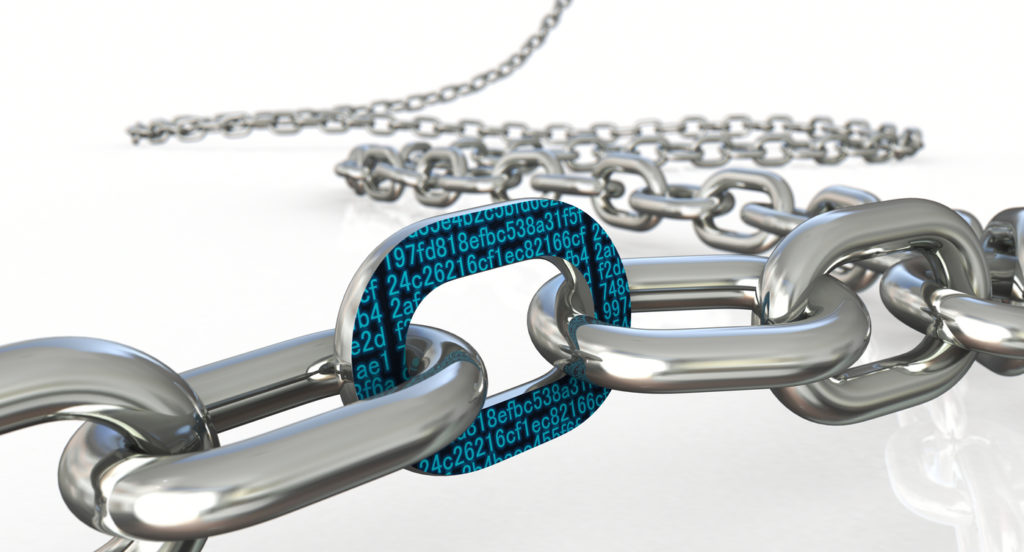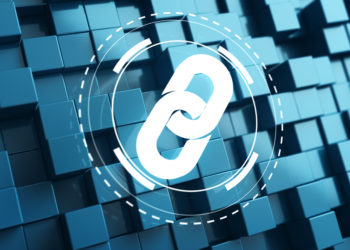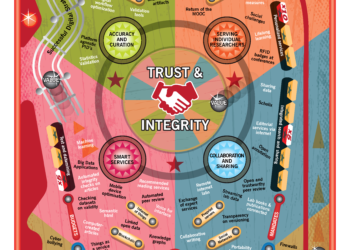Blockchain seems to be the word of the moment — both in scholarly communications and elsewhere. And it elicits strong opinions, both positive and negative, even though many of us aren’t completely sure what it is! Is it really going to transform scholarly communications, or is it just another flash in the pan?
In the description of their PIDapalooza presentation on the topic, Geoffrey Bilder (Crossref) and Martin Fenner (DataCite) put it like this: “In the past, at least one of us has threatened to stab himself in the eyeball if he was forced to have the discussion [about blockchain] again. But the dirty little secret is that we play this game ourselves. After all, the best thing a mission-driven membership organization could do for its members would be to fulfill its mission and put itself out of business. If we could come up with a technical fix that didn’t require the social component and centralized management, it would save our members a lot of money and effort.”

In this interview, Joris van Rossum (Director of Special Projects, Digital Science) and author of Blockchain for Research, and Martijn Roelandse (Head of Publishing Innovation, Springer Nature), discuss blockchain in scholarly communications, including the recently launched Peer Review Blockchain initiative (disclaimer: my organization, ORCID, is also involved in the initiative).
How would you describe blockchain in one sentence?
Joris: Blockchain is a technology for decentralized, self-regulating data which can be managed and organized in a revolutionary new way: open, permanent, verified and shared, without the need of a central authority.
How does it work (in layman’s language!)?
Joris: In a regular database you need a gatekeeper to ensure that whatever is stored in a database (financial transactions, but this could be anything) is valid. However with blockchain, trust is not created by means of a curator, but through consensus mechanisms and cryptographic techniques. Consensus mechanisms clearly define what new information is allowed to be added to the datastore. With the help of a technology called hashing, it is not possible to change any existing data without this being detected by others. And through cryptography, the database can be shared without real identities being revealed. So the blockchain technology removes the need for a middle-man.
How is this relevant to scholarly communication?
Joris: It’s very relevant. We’ve explored the possibilities and initiatives in a report published by Digital Science. The blockchain could be applied on several levels, which is reflected in a number of initiatives announced recently. For example, a cryptocurrency for science could be developed. This ‘bitcoin for science’ could introduce a monetary reward scheme to researchers, such as for peer review. Another relevant area, specifically for publishers, is digital rights management. The potential for this was picked up by this blog at a very early stage. Blockchain also allows publishers to easily integrate micropayments, thereby creating a potentially interesting business model alongside open access and subscriptions.
Moreover, blockchain as a datastore with no central owner where information can be stored pseudonymously could support the creation of a shared and authoritative database of scientific events. Here traditional activities such as publications and citations could be stored, along with currently opaque and unrecognized activities, such as peer review. A data store incorporating all scientific events would make science more transparent and reproducible, and allow for more comprehensive and reliable metrics.
But do you need a blockchain to build this datastore?
Joris: In principle, no, but building such a central store with traditional technology would imply the need for a single owner and curator, and this is problematic. Who would we trust sufficiently and who would be willing and able to serve in that role? The unique thing about the blockchain is that you could build this database without a single gatekeeper — trust is created through technology. Moreover, through cryptography you can effectively manage crucial aspects such as access, anonymity, and confidentiality.
Why is blockchain so divisive — both in scholarly communication and more widely? Why do some people love it and some hate it?
Joris: I guess because of blockchain’s place in the hype cycle. Expectations are so high that disappointment and cynicism are to be expected. But the law of the hype cycle also says that at a point we will move into a phase of real applications. So we believe this is the time to discuss the direction as a community, and start experimenting with blockchain in scholarly communication.
Martijn: In addition, bitcoin, built on top of blockchain technique, is commonly associated with black markets and money laundering, and hasn’t built up a good reputation. Blockchain, however, is so much more than bitcoin. Blockchain for business does not require any mining of cryptocurrencies or any energy absorbing hardware. In the words of Sally Davies, FT Technology Reporter, “[Blockchain] is to Bitcoin, what the internet is to email. A big electronic system, on top of which you can build applications. Currency is just one.” Currently, blockchain is already much more diverse and is used in retail, insurance, manufacturing etc.
How do you see developments in the industry regarding blockchain?
Joris: In the last couple of months we’ve seen the launch of many interesting initiatives. For example scienceroot.com. Pluto.network, and orvium.io. These are all ambitious projects incorporating many of the potential applications of blockchain in the industry, and to an extent aim to disrupt the current ecosystem. Recently artifacts.ai was announced, an interesting initiative that aims to allow researchers to permanently document every stage of the research process. However, we believe that traditional players, and not least publishers, should also look at how services to researchers can be improved using blockchain technology. There are challenges (e.g. around reproducibility and peer review) but that does not necessarily mean the entire ecosystem needs to be overhauled. In fact, in academic publishing we have a good track record of incorporating new technologies and using them to improve our role in scholarly communication. In other words, we should fix the system, not break it!
What is the Peer Review Blockchain initiative, and why did you join?
Martijn: The problems of research reproducibility, recognition of reviewers, and the rising burden of the review process, as research volumes increase each year, have led to a challenging landscape for scholarly communications. There is an urgent need for change to tackle the problems which is why we joined this initiative, to be able to take a step forward towards a fairer and more transparent ecosystem for peer review. The initiative aims to look at practical solutions that leverage the distributed registry and smart contract elements of blockchain technologies. Each of the parties can deposit peer review activity in the blockchain — depending on peer review type, either partially or fully encrypted — and subsequent activity is also deposited in the reviewer’s ORCID profile. These business transactions — depositing peer review activity against person x — will be verifiable and auditable, thereby increasing transparency and reducing the risk of manipulation. Through the shared processes we will setup with other publishers, and recordkeeping, trust will increase.
A separate trend we see is the broadening scope of research evaluation which triggered researchers to also get (more) recognition for their peer review work, beyond citations and altmetrics. At a later stage new applications could be built on top of the peer review blockchain.
When are current priorities, and when can we expect the first results?
Martijn: The envisioned end-game for this initiative is a platform where all our review activity is deposited in a blockchain that is not owned by one single commercial entity but rather by the initiative (currently consisting of Springer Nature, Digital Science, ORCID), and maintained by an Amsterdam-based startup called Katalysis.io. A construction that is to an extent similar in setup to Crossref.
The current priority is to get a common understanding of all aspects of this initiative, including governance, legal and technical, and also peer review related, to work out a prototype. We are optimistic this will be ready by September of this year. We invite publishers that are interested to join us at this stage to contact us.
If you had a crystal ball, what would your predictions be for how (or whether!) blockchain will be used in scholarly communication in 5-10 years time?
Joris: I would hope that peer review in the blockchain will have established itself firmly in the scholarly communication landscape in three years from now. And that we will have started more initiatives using the blockchain, for example those around increasing the reproducibility of research. I also believe there is great potential for digital rights management, possibly in combination with new business models based on micropayments. But, this will take more time I suspect.
Martijn: I agree with Joris, I hope our peer review initiative will be be embraced by many publishers by then and have helped researchers in their quest for recognition for peer review work. At the same time, I think there is more to come in the blockchain space as it has the potential to change the scholarly publishing industry, and solve many of its current day challenges by making processes more transparent and traceable.
* Perhaps not quite everything!
Discussion
29 Thoughts on "Everything* You Always Wanted To Know About Blockchain (But Were Afraid To Ask)"
One thing I don’t understand about blockchain application in scholarly communication is: if science is a collective enterprise, how does decentralization fit in; how does decentralization advance a collective enterprise?
All I can make out of it so far is excess tokenization of standard processes in scholarly communication — so a paper is 1 ScholCoin; a dataset is 5 ScholCoins; a citation gets you 0,5 ScholCoins per; you review something, you get 0,1 ScholCoins; other folks “upvoting”/”liking”/”endorsing” your review, that’s 0,05 ScholCoins per; etc. you get the idea… So yay, exit Impact Factor, enter ScholCoin I guess.
The most important question Alice asked here is: do we need blockchain?
And as long as the answer is “in principle, no”, is there any genuine need to tack blockchain on an already pretty dysfunctional system?
Just to be sure, we won’t be delving any cryptocurrencies with this initiative nor handing out ScholCoins (although +1 for the name)… What we try to achieve here is that review activity data store where the review process can be independently verified and where review activity is fed to ORCID researcher profiles (via opt-in). And it will be a similar construction as Crossref, publishers working together for the benefit of reviewers in a non-profit organisation.
Understood; it’s just a general blockchain tendency I noticed.
As for the solution you’re developing, will it allow independent verification of the content/quality of reviews, or just the process?
For now the process but I would be very happy if we could add some quality measure/indicator at a later stage.
Your question is spot-on. Science is a collective enterprise, but is in need of centralized services to store, validate and disseminate that information (e.g. databases, publishing houses). The promise of blockchain is that science could be served by a collective, decentralized technology – blockchain! So we do need it – perhaps not. But potentially, it could greatly benefit from it.
The basic premise of Blockchain is not just decentralisation but also taking the system away from profit-seeking mega corporations. Looks like STM publishers are ignoring the “real” problems of barriers to access (across the world, across archives, across basic research output) which they maintain by hoodwinking with these high-tech “solutions”. Profit making isn’t the problem, it is the dishonesty that is.
no.. readcube or sharedIT don’t remove barriers to access.
So the gatekeeper becomes the programmer(s) and technology – whatever that is – becomes the regulator. This reminds me of MBA speak.
Validating the peer review process is an interesting application for blockchain, given the press over fake (author-generated) reviews. The solution, however, does not require blockchain, and imposes a practical problem:
Consider a manuscript that goes out for review. It is sent to three external reviewers, all of whom send blockchained reviews that are validated by the network. One of these reviews includes personal (sexist, racist) and other ad hominem remarks about the author. If I understand the model correctly, this review cannot be edited by a section editor or EiC, as this would corrupt the transaction. The best an editor could do is write a response, hoping the author understands that these irrelevant comments won’t be taken into editorial consideration.
Can you conceive of a blockchain solution that solves the bad reviewer problem? The current editorial model can be somewhat opaque, but opaque also comes with beneficial effects.
Bad reviewer problem? I am more worried about the bad editor problem.
..and then there are “bad authors” and “bad publishers” and “bad retailers” and “bad typesetters”…where does this end? If we focus on innovation to avoid “bad” then we aren’t really innovating. Notoriety is an evolutionary trait and it will reappear in other forms. We need to innovate for “good”.
Hi Phil, two answers to your question. First of all, using the blockchain for peer review does not mean that all the content will be automatically stored. As a matter of fact, we want to start with capturing the metadata of the review process (e.g. reviewer X has reviewed paper Y, and has given recommendation Z). This would already make the process more transparent, and allow to feed for example reviewer recognition profiles.
Second, using the blockchain does not mean that we cannot change information, but that we cannot change information without that being recorded. So in your example, it would be possible for the reviewer or editor to change a review report after feedback, but that this happens would be traceable. But also here, what we will record and what not will be decided as a community.
Blockchain is supposed to be an anonymous ledger system. So how are you squaring this with identification of peer reviewers, etc.? Or are you just thinking that certain parts of the blockchain stack would be used (hashing, Merkle trees, etc.) to validate things better, and calling that blockchain?
Kent, Blockchains are not anonymous, but rather pseudonymous. Think of them like a Swiss bank account. A Swiss bank account has no information tying it to a specific individual. However, once someone’s identity has been connected to the bank account, it is not possible to “hide” that link anymore. Blockchains accounts are the same, plus have the extra property that the data on a blockchain is immutable (you cannot delete it or overwrite it, just record a correction to the data). So the problem is more to protect the identity of reviewers rather than be able to identify them in the first place. This can be achieved through various cryptographic operations.
So, essentially, in this pseudonymous system (also described by some as anonymous or pseudoanonymous), you need data from another source to identify the pseudonymous blockchain player or reviewer, which means linking a real identity to a blockchain address, or multiple blockchain addresses. So, then, the security threat shifts to the system holding the data linking real identities to blockchain addresses, correct?
Also, you’re really just talking about hashing as the cryptographic technique, right?
Kent, allow me to insist and reiterate that most blockchain implementations do not provide anonymity. It is a misconception which too often leads to misunderstanding of what blockchains provide as a technical solution (Trust through transparency and immutability). You are correct in saying that the security focus should be where the relationship between the user id and the blockchain address is held, which is effectively where it currently lies in traditional systems not using blockchains.
Regarding the cryptographic algorithms, hashes are able to achieve a one way encoding of an identity indeed, however one would also want signing capabilities to be able to guaranty authentication of the party storing the data, and possibly encryption as well if there is a requirement to reverse the encoding.
We had a very interesting Blockchain Session in the APE 2018 Conference in January in Berlin and of the Speakers, Dr. Sönke Bartling, is now preparing:
1st international Conference on Blockchain for Science, Research and Knowledge Creation
6-7 November 2018 in KNOW Berlin
http://www.blockchainforsciencecon.com
This conference will be held under the Auspices of the Alexander von Humboldt Institute for Science and Society (HIIG).
Issues:
With blockchain and some form of tagging the site could be a general scholarly depository searchable by subject rather than journal for review and acceptance as well as user access whether pre or post review or final version. One must remember that blockchain is not a technology that can be considered separate from the larger technology evolution.
Interestingly it might make peer review more honest and open particularly where reproduction of experiments or validating an article/analysis is concerned. Reviewers could be held responsible. It might eliminate the persiflage submitted for pub/perish,
Publishers seem to understand that researchers search for subject matter of interest. BC could eliminate the weaker journals as BC gateways and hence the current business model would change.
The impact on academic research institutions, also considering the current reduction in tenured faculty, could parallel.
Journals as platforms as well as Academic institution as platforms, not just what is on these platforms need careful consideration
Thank you all for this! … here are some follow-up questions from one who is REALLY trying to “get” blockchain and still struggling! (All questions here are coming from a point of ignorance rather than scepticism – apologies if my tone sounds challenging at any point; it’s not intended to!)
1. What constitutes “data” and how does it “self-regulate”? If I undertake a peer review (say) and that action is captured by a blockchain-based system, is that “data”? What aspect of it needs regulating (my appropriateness as a reviewer?)? And literally (step by step) how does blockchain actually do that?
2. Can you give more examples around “consensus mechanisms clearly define what new information is allowed to be added to the datastore?” Are things “allowed” because there is a field for them (e.g. if I completed a review, the “has completed a review” field would go from “false” to “true”, but additional data such as “drank coffee while completing the review” wouldn’t be “allowed” unless a field for that was also created?) Or is “allowed” more about validity of the data e.g. you could add “Charlie Rapple” in the “who completed the review” field but not “Charlie 57 Rapple” because numeric characters are not allowed in that field (say). So, a) what sort of things are defined by consensus mechanisms? And b) how are those consensuses created? Is there a human element or is it machine learning? (at the bounds of my ability even to articulate my questions, now!)
3. Probably building on 1+2, how is “trust created through technology”? Isn’t there still a need for trust in the people / orgs designing the platform and aren’t they then gatekeepers?
4. Could you elaborate on why blockchain is an easier way for publishers to integrate micropayments than current e-commerce systems? Isn’t it just a different technology choice, with likely the same implementation implications, (or indeed more, if publishers already have an entrenched e-commerce system)? Or is it somehow easier to implement?
5. In the peer review context, how is the deposit of peer review activity different to e.g. Publons, where reviewers can assert that they undertook a review and this can be validated by the publisher? I get your point about review activity being owned by a collaboration rather than a single commercial entity, but isn’t that about the business model rather than the technology? (I suppose again my question is, is blockchain adding some unique value here or is it one technology, potentially among others, that a co-operative could use to develop a cross-industry platform?)
Thanks in advance for any further answers you can provide!
Charlie – regarding your question/observation #5 – journals can also post reviewer/review acknowledgements directly from peer review systems such as Editorial Manager to an authenticated ORCID record. In this model the authority is the journal/publisher, but the individual ORCID iD owner also has to give permission:
https://www.ariessys.com/views-and-press/resources/video-library/orcid-reviewer-recognition/
The consensus mechanism is between participating publishers, ORCID and Katalysis. We’ll have to determine what kind of activity (i.e. the data) do we want to store? E.g. has the manuscript been peer review and by whom, how long was the peer review time and for which journal. We are currently defining which of these elements are essential, which are nice to know and so on but also lay the groundwork for further governance.
Hello Charlie! My name is Alex Shkor, I’m CEO and founder of DEIP.world – decentralized research platform (unfortunately not mentioned in the article, though we presented DEIP in November 2017 at Blockchain For Science event).
You raised really good questions, I can not pass by, without answering them all. I’ll do this from the perspective of our implementation of decentralized research platform.
1) I would say that decentralized research platform is a self-regulated system, not just self-governed data. And it means that the system works exactly the way it was programmed. And no one can change or intervene the way it works. Our team has built unique public blockchain that provides progressive funding mechanisms, open-access publishing platform, and advanced review system. It is entirely governed by the scientific community. You might ask how this governance exactly works. Here it is: We have internal expert tokens system, which designed to fairly reflect expertise and contribution of each person in any specific field. The greater contribution to a scientific discipline you made the more expertise tokens you earn. Expertise token is core entity for self-governance in our system. They are specific for each discipline. With expertise tokens, you can assess review research in a specific discipline. And by this decentralized assessment of the whole scientific community, the system knows how to rank each research and each review. And having this ranking DEIP platform automatically distributes rewards to scientists who made a contribution. This incentivizes to make a better contribution to knowledge creation and enhance the whole scientific environment.
2) Not sure that in the article there is a correct definition of consensus mechanism, but in general consensus mechanism just select a peer or node who will include data into blockchain. It’s crucial because the system is decentralized and everyone can potentially write to the blockchain, so consensus solves any conflicts in transactions. Public blockchains are designed in such a way that it’s impossible to apply censorship on what data can be included because if current selected peer (block procedure) will censor your transaction, next one might include it. And only if the whole community will decide to censor you, you will potentially have problems submitting your data. But still in public blockchain, anyone can become a block producer, so you too, and then your data anyway will be included into blockchain.
3) Blockchain does not create a trust (I don’t think any technology just can’t do this). But blockchain provides trustless mechanisms of peer-to-peer interaction. This comes from this feature, that blockchain operates as it has been designed, and no one can intervene this algorithm. You raised a good point about people/org who designed the system. Yes, they better to be trusted when they launch the system. But after it’s launched they don’t really have a control over it. They even can’t update it to the new version without this update being agreed by the whole community.
4) Personally, I think micropayments should not exist in a system designed to promote scientific knowledge creation. Knowledge should be spread for free, and there should be no barriers for researchers to publish their finding. This what I would change in the current system, and this what we do with DEIP. In DEIP whole functionality if free for end-users. This is the beauty of blockchain – we can provide everything for free and don’t worry about any monetization models. Our infrastructure is autonomous and self-sustainable because there is incentivization for block producer to maintain the network (they are paid from emission for their work).
5) Yes, the unique value is that we can add incentivization for reviewers to produce qualitative reviews and for research because their reward depends on the quality. This is actually shallow view on how reviews work in DEIP.
I would be happy to answer any your questions about DEIP and blockchain in general! You can drop me an email (alex@deip.world) or ask you questions on our community portal http://community.deip.world/. Feel free to check our whitepaper for more details about DEIP http://deip.world/whitepaper/
Me again! Just started reading the post again and I suppose what I’m saying in 3 + 5 is: when you say “without the need of a central authority”, won’t the Springer Nature, Digital Science, ORCID group be acting as a central authority, shaping the development of the platform, its functions, what data / actions are / aren’t permitted, etc? as noted above, I’m not trying to split hairs, and I may just really not “get” this!
I second Charlie’s questions–thank you for taking the time to formulate them. The short of them, as I take it, is 1) What problems does blockchain solve for scholcomm? 2) Is it better at solving them than existing or alternate mechanisms? and 3) Is it more fair/neutral? (Addendum to 3): transparency is not the same as fairness; transparency works as a means of ensuring fairness and honesty only if there are mechanisms to report on and publicize or otherwise deter bad actors.)
Hi – this is a really interesting project and I look forward to seeing the results. I wanted to ask about the issue that Charlie raised about the need for a “central authority”. In the interview it says there is no curator and “trust is created through technology” without a “central authority”. This doesn’t seem consistent with subsequent comments that initially “participating publishers, ORCID and Katalysis” will set things up and then “evolve into a organization representing all STM publishers”. Collaborative projects and organizations are a common way of doing things in scholarly communications so it seems that this project is looking at a technical way for different organizations to agree a set of rules and procedures to solve a particular problem and then implement a service using blockchain. Whether blockchain is the best way to solve the problem will be interesting to see but it doesn’t seem like it will remove the normal governance and operational overhead for this type of thing.
Thanks for this timely informative piece. I’m now slightly further down the road of understanding, but hit a speed bump when I came to the phrase “trust is created through technology.” If there persists an underlying assumption of distrust – whether against commercial STM publishers or other players – can a tech solution really change the landscape for scholarly communication?
Hi Sara and Charlie, thanks for your questions. It’s true that Springer Nature, Digital Science, ORCID will be acting as a kind of central authority, shaping the development of the platform, its functions. But the goal is that this will evolve into a organization representing all STM publishers. So the initiative will be owned by the community, not be a central (commercial) entity. In a way similar to organizations like Crossref and ORCID, with that difference that the blockchain is a technology that supports this structure really well. Concerning the other detailed questions about how blockchain works, see also the Digital Science report, which also includes links to more detailed background information (https://figshare.com/articles/_/5607778). Also feel free to contact me directly when you have more questions!
When any emerging technology comes out with a strong suspicion, the reason for the question is that the technical maturity is not enough, and there is no representative solution. But this does not interfere with human exploration. The same is true of the application of blockchains in academic publishing.
At present, some entrepreneurial teams have announced their products and white paper, and the existing solutions can be used to determine whether the blockchain applied to academic publishing is of any value.
I have now read the report. The primary issues it identifies have to do with 1) rewarding aspects of scholarly work that are not now rewarded–peer reviewing, replication studies, and collaboration, for example–and 2) getting rid of the costs of subscribing to publishers’ products. 1) Accurately recording the fact that these occurred (that someone did so many peer reviews, etc.) or enabling them to occur by providing a platform for sharing data could be done with blockchain. But the issue that needs solving is not the recording or sharing, but the reward. “Virtual currency” (one possibility offered) will not do it; creating “real” cryptocurrency gets us into the costs of mining, which is paid for by whom? The rewards that matter are up to the funding organizations or employers of scientists. They can recognize these activities but have chosen not to, and not because it’s not possible to track them. 2) The other problem this proposes to solve is the cost of accessing content. This is supposed to happen by enabling micropayments directly to the researchers who post their content (publishers can then shift their business to providing peer review and copyediting). So it doesn’t really solve the problem of paying for access, just shifts it to the researcher, and of course doesn’t address any of the other problems that are currently solved by publishers. (I’m fine with blowing up the big science publishers; this won’t do it.)



